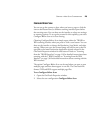
CREATING A NEW SCAN CONFIGURATION 89
The file name formats are:
{USER}, {seq}.{ext}—File names begin with your user name
(that you use to sign on to the SharePoint server), followed by
the sequential number of the scanned document, and then the
extension for the type of file. Examples: JohnDoe0001.pdf,
JohnDoe0002.pdf, JohnDoe0003.pdf... and so on.
{USER}, {Y.M.D H.M.S}.{ext}—File names begin with your
user name, followed by the date and time (Y
ear Month Day
H
our Minute Second) when the document was scanned, and
then the extension for the type of file. Examples: JohnDoe
08.22.07 09.35.16.pdf, JohnDoe 08.22.07 09.35.45.pdf,
JohnDoe 08.22.07 09.36.10.pdf... and so on.
{Y.M.D H.M.S}.{ext}—File names start with the date and time
(Y
ear Month Day Hour Minute Second) when the document
was scanned, followed by the extension for the type of file.
Examples: 08.22.07 09.35.16.pdf, 08.22.07 09.35.45.pdf,
08.22.07 09.36.10.pdf... and so on.
{prefix}, {seq}.{ext}—File names begin with a prefix you
specify, followed by the sequential number of the scanned
document, and then the extension for the type of file.
Examples: Invoice0001.pdf, Invoice0002.pdf,
Invoice0003.pdf... and so on. In these examples the prefix is the
word “Invoice”.
Filename Prefix—Click in this box and type the prefix to use if
you’re using the {prefix}, {seq}.{ext} format. In the previous
examples, the word typed in this box would be “Invoice”. Using
a prefix is a good way to identify scanned documents that apply
to the same subject. For example, the prefix might be: the
docket number of a legal case, the code name of a research and
development project, or the name of a site where a set of
scanned pictures were taken.
Count—The number of files the SharePoint link has transferred to
the SharePoint server. Each time a new document is sent to the
server the count increases by one. The Count is also the sequence
number ({seq}) used in the file name formats described above. To


















